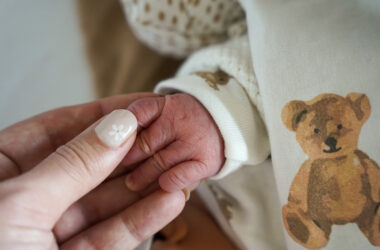C-section versus vaginal delivery
My name is Birgit, I am almost 30 years old and the mother of two beautiful children: Jara, aged three and a half years, and Senn, eight months old. Three and a half years ago, I delivered our daughter at 36+4 weeks by means of an emergency cesarean section and eight months ago, I gave birth to our son vaginally. In both cases, it was a wonderful experience, but both cases were also completely different.
A quick recap of my pregnancy with our eldest
While pregnant with our daughter, I developed high blood pressure on the day I went on maternity leave. This led to numerous hospital visits and check-ups. Eventually I was given medication to stabilize my condition. Where I previously had to go in for a check-up every other day, I was now permitted intervals of one week between check-ups once the medication took effect. On Monday, October 26, I returned to the hospital for a check-up. As usual, the nurse chatted with me before taking my blood pressure. She asked me if I was still feeling the baby doing well in my womb; this gave me pause, and I realized that our baby had been rather quiet since the day before. To be on the safe side, the nurse did a CTG.
The baby was inactive, with an increased heart rate
On this CTG, I immediately saw the high heart rate of the baby, which was around 180 beats per minute, as opposed to 110-160 beats per minute, which had been the normal reading in previous examinations. Very often, our baby would then wake up and be active, but not this time. Only her heart rate increased, but she showed no form of activity. I was placed on my left side, but this did not help either and there was little variation in the heart rate. The nurse checked my “complaints” about high blood pressure and measured my blood pressure repeatedly. Then, all of a sudden, everything happened very quickly. The obstetrician came to pick me up in a wheelchair because I was no longer allowed to walk, and she made an ultrasound. Again, our baby showed no movement.
Discover and stimulate your baby's mental development
Download nowTime was of the essence

I was admitted and immediately after arriving at the ward, they performed all kinds of tests. I also went back on the CTG. The baby’s heart rate had risen to 210 beats per minute. After an additional ultrasound and consultation with the nearest pediatric hospital, the heart rate suddenly dropped to a “normal” reading. Just when we thought, we might be able to go home again, the gynecologists told us that time was of the essence. We went into the OR, and our daughter was born soon after. Overwhelmed by the rapid sequence of events, we welcomed her, and she immediately went for a check-up with the pediatrician. Our daughter was doing well under the circumstances, so she could and was allowed to lie on my chest.
Recovery after a c-section
In physical terms, a cesarean section is no mean feat. It leaves you with a large wound that makes it impossible to stand for a long time or to bend over. Moreover, it’s a major abdominal operation, after which you have to get back on your feet and take care of your baby barely 24 hours later. In addition, you have been given medication to keep you stable during surgery and a catheter, so you are not very mobile.
Jara was admitted to the neonatology shortly afterwards because her reflexes did not respond properly to stimulation and she did not drink well, so I went beyond the limits of my body to be with her as much as possible. I understand that this happens frequently and no matter how logical I thought it was at the time, in retrospect I sometimes think, what was I doing and why did nobody stop me?
Coping mentally with a c-section

Coping mentally was a very intense process for me. During my pregnancy, we participated in a birthing course, in which we never really considered an (emergency) C-section for a single moment. I was so set on creating a bubble, on creating a calm and peaceful space and the magical moment of our meeting that having to undergo the C-section felt like a failure and a big disappointment. I hadn’t physically worked to bring my baby into the world, and for a long time I just called it “birthing.” It seemed like the “easy” way when I talked about it with others: I had no idea what contractions were, what dilation felt like or what a placenta looked like.
When it came to giving birth, I never really felt as if I was part of the conversation. In these situations, people often told me to be grateful. If you recognize or are familiar with this sentiment, please be aware that there are many mothers who have given birth by C- section and feel this way. It’s not surprising, you’re not alone. Contact with other mothers who had given birth by cesarean section helped me to normalize these feelings and thoughts and to find recognition.
Vaginal delivery
8 months ago, in my second pregnancy, I went into labor. As an abnormality in my placenta had been discovered while I was pregnant with our daughter and this presented a risk of recurrence, we had agreed with the gynecologist not to exceed the gestational age of 40 weeks. When I reported to hospital for the induction of the labor, I couldn’t be induced right away, so we had to prep. This was done with pills at first, but it didn’t work so well, so they inserted a balloon the next day.
The next day I was sufficiently dilated to break my water. After the membrane had ruptured, they also gave me contraction inducers, which got the contractions going very quickly. Dilation still did not progress after 5 hours, so I opted for an epidural. This really helped me to relax. Before that, I was quite tense and the CTG kept cutting out, which triggered me.
Another 12 hours until full dilation
After the epidural it took another 12 hours before I was fully dilated, but I remember it as an agreeable phase (in which I should have rested for a while, ha-ha). When it was time for me to begin pushing, I noticed that my whole body began to feel restless. I was allowed to slowly press a bit, but not to push in full. This was really quite stressful for me at one point, causing me to feel super nauseous and to vomit. As soon as they gave the go-ahead to push, I immediately knew what I had to do.
What helped me at this stage was that I heard and saw real progress during the pushing. I pushed for 90 minutes, sometimes thinking by myself, “when is this going to end?”. After 90 minutes of pushing, my husband grabbed our son and placed him on my chest. What a reward for hard work: I had brought him into the world all by myself, which was a wonderful sensation! The “golden hour” was simply beautiful, and our son was strong enough to drink straight from my breast.
Recovery after vaginal delivery
Physically, I felt completely fine. I was able to take a nice shower two hours later, after which I could go with my son to the ward, where he was admitted for observation. I was able to walk on my own, care for him, and the best thing of all was that I had not taken any medication, so I felt much more clearheaded (even after being awake for more than 26 hours and having just given birth).
Coping with the process of giving birth was also quite different: I was ready for the birth (which had not been the case with my daughter), and I really worked during the birth towards the moment he arrived. The obstetrician also explained later that childbirth combines two elements: it ends your pregnancy and launches you into the world of having a baby. With a cesarean section, this is quite different, and even more so if it is an emergency situation. In physical terms, the period after childbirth also differs. The biggest difference is that you don’t end up with a wound which has to close and heal, which literally limits your movements, but a vaginal birth involves completely different issues, too.

For example, on the first day, sitting down was quite a problem. And because of the catheter I got with the epidural, I couldn’t feel my bladder. As a result, I had to be catheterized a number of times. In the end, it all worked out. I did notice that my pelvis and pelvic floor had to recover.
Difference between c-section and vaginal delivery
Two wonderful moments in my life. Both are quite different, but each with a wonderful outcome. The process of recovery after both births differed considerably: the challenges − both physically and mentally − are quite different. The main thing is that you have to listen to your body when it comes to physical recovery. You have to allow yourself sufficient time and space to cope mentally with everything. I think that in general there is still room for improvement in slowing down the pace for new mothers and for allowing them to fully relax for a while. This is a luxury we have here in the Netherlands, of course, because of maternity care.
Here are also some tips for moms-to-be, namely:
- Prepare yourself for the possibility that you may have to undergo a C-section. Read up or look at what this entails, and perhaps you should also draw up a “birth plan” for this option.
- For the period after childbirth in either case: take it easy and allow yourself to be pampered. You really need time to recover.
- And last but not least, think about a birth photographer. If you ask me, it’s the most valuable gift you can give yourself, your partner and child.
Did this article help you?
Share this article
Receive a notification at the start of a leap!
Would you like to be prepared when your baby is about to enter a leap? Sign up for our leap alarm for free and always receive a notification when a leap is about to start!




